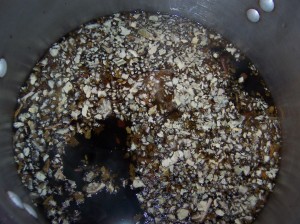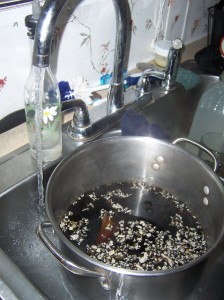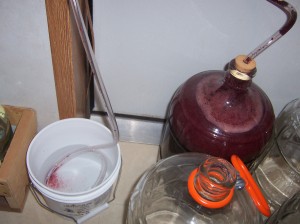Today is Mead Day! Since 2002, the American Homebrewers Association has designated the first Saturday in August as such. There are many ways to celebrate Mead Day, but I decided to definitely do up a batch of mead. Blueberries are in season, so they are a natural choice.
The wife picked up a bunch of wild blueberries at the farmer’s market today, and man are they gorgeous! I couldn’t decide what to add to it herbally, apart from chaga…. last year I did a Blueberry Nettle Mead and it was ok, but I wanted to experiment with something different. The wife suggested Mullein, saying she had a good feeling about it, and that was one of two herbs I was considering (along with a nettle repeat). So Mullein it was!
Mullein
Mullein (Verbascum densiflorum) is a very striking plant. It has a tall stalk, and its leaves are incredibly big and soft (they make the supreme natural toilet paper when doing one’s bidness in the wild). Mullein has been used by humans for thousands of years:
The name mullein itself is derived from the Latin word “mollis” which means soft. It has its origins in the Mediterranean, but has been naturalized in North America. The flowering stem was dried by the Greeks and Romans and dipped in tallow, and then used as a lamp wick or as a torch.
The soothing mucilages of mullein coat sore throats and make coughing more productive. The German E Commission relates that mullein is good for catarrhs of the respiratory tract and as an expectorant.
So I began as I always do, with a chaga decoction, letting 2 gallons of water simmer overnight to make a thick, dark tea. When I turned the heat off, I added 3 black tea bags and a few handfuls of dried mullein leaf:

I let this steep for about 10-15 minutes and then began cooling it, using my new favorite cooling method of putting the stockpot into the sink and filling the sink around the stockpot with cold tap water. I drained the water and refilled it once, and it was down to blood temperature after about 20-30 minutes:

Once the tea was cool, I strained it and set it aside for a bit.
Next were the blueberries. In the past, I’ve used as little as a pint, and more often a quart, of berries in my meads. This time I wanted to try a higher concentration of berries, so I used 3 pounds (about 2 quarts) of fresh, wild blueberries. I blended them a quart at a time in my VitaMix high speed blender, poured them into the stockpot, and then added a bit of the tea in the blender, and whizzed that too to get as much of the blueberry goodness as possible:

I then added the tea, and enough honey to get us up to 19% initial alcohol potential, and mixed it up well:

Then I pitched the yeast, transferred everything to the carboy, shook it up, and labeled it, leaving a beautifully-colored carboy full of mead-to-be:

There are a lot of blueberry skins in tiny bits; between that and the double-blueberry load I expect a lot of sediment in this batch. Time will tell…..
Happy Mead Day to all of my readers!
UPDATE: 4 hours later….

Well, this hasn’t happened in a while. 4 hours in, it foamed up pretty vigorously, clogging the airlock. (I would have taken a pic of it, but my wife had already cleaned it by the time I got the camera. :-)Â I’m glad she caught it when she did!
To review for my readers, if I hadn’t have removed the airlock the pressure would have continued to build and eventually popped off, making a MUCH bigger mess. As it was, I set the carboy outside, just outside the visible door here — I usually start my ferments near the door for exactly this reason, I can aim the carboy outside if it really starts to shoot, which has only happened once so far.)
Then, stuff the opening in the rubber stopper where the airlock goes with your siphoning hose, and put the other end of the siphoning hose into a bucket of water, making sure the other end of the hose is always underwater. This duplicates the airlock, but gives the bubbles/foam space to blow off without making a mess or building pressure.
THOSE OF YOU MAKING MEAD WITH 2 QUARTS OF BERRIES, TAKE NOTE. THIS HOBBY CAN BE MESSY. :-D
UPDATE: Sept 20
I just racked this mead. It is 6% remaining alcohol potential, which means this brew is 13%ABV. The blueberry flavor really comes through strongly! Once this ages it will be fantastic. It’s a gorgeous dark color….
